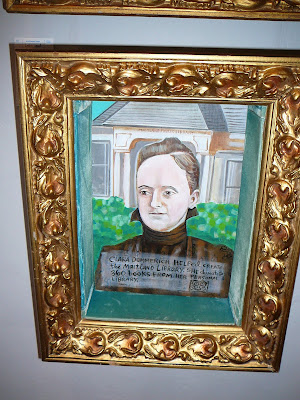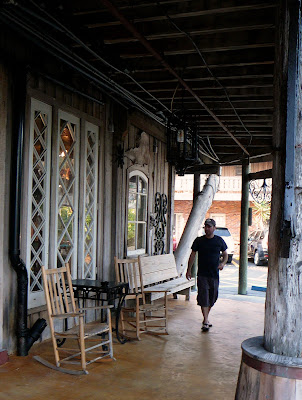 I read once that in the days of the Seminole Indian Wars, forts were built one day's march from each other, throughout Central Florida. Fort Maitland, (built in 1838 during the 2nd Seminole Indian War), was the fort located a day's march from Fort Mellon in Sanford to the north and a day's march from Fort Gatlin in Orlando to the south. After the hostilities with the Indians ended, settlers moved into the area around Fort Maitland because of the "natural spring water and extensive pine forests" according to this online history of the city.
I read once that in the days of the Seminole Indian Wars, forts were built one day's march from each other, throughout Central Florida. Fort Maitland, (built in 1838 during the 2nd Seminole Indian War), was the fort located a day's march from Fort Mellon in Sanford to the north and a day's march from Fort Gatlin in Orlando to the south. After the hostilities with the Indians ended, settlers moved into the area around Fort Maitland because of the "natural spring water and extensive pine forests" according to this online history of the city. The rich and powerful, including Presidents Chester A. Arthur and Grover Cleveland, wintered in Maitland hotels
The rich and powerful, including Presidents Chester A. Arthur and Grover Cleveland, wintered in Maitland hotels
 Citrus production was a major source of Maitland's growth in the early twentieth century. Images from the State Archives of Florida
Citrus production was a major source of Maitland's growth in the early twentieth century. Images from the State Archives of FloridaThe Maitland Historical Society and Museums is the organization that preserves the heritage of this Central Florida town that former Sentinel columnist Bob Morris jokingly nicknamed the "land of mates." Recently the Historical Society merged with the Maitland Art Center and one of their first moves as the Maitland Art and History Association was to present an exhibit of artwork of Maitland's pioneers by artist Dawn Schreiner.
Dawn and her family have lived just outside the Maitland city limits for fifteen years, which means I've known her and her husband for around two decades. The Schreiners are avid Florida history buffs and they spend their weekends taking their two kids, Toby and Elena, to some of our state's most obscure and interesting historical places like the DeLand Hospital Museum and Shady Oak Restaurant and Tavern on the St. Johns River. It makes me very happy to know that some kids are being brought up on a healthy diet of Old Florida, and it gives me hope that future generations may be interested in preserving Florida's past.
 Here's a Q&A I did with Dawn about her work in Maitland:
Here's a Q&A I did with Dawn about her work in Maitland:Q. What inspired you to do a show about Maitland pioneers?
A. I've always been interested in history, pioneers and portraits. When I heard the Maitland Art Center and the Maitland History Center were merging, the idea of painting portraits of Maitland pioneers came to me, while I was walking around Lake Catherine (in Maitland).
Q. What makes Maitland so unique?
A. Maitland is unique in that it doesn't have a port, which was commonly a city builder in the old days. People had to take steamboats to Jacksonville or Sanford. From there they travelled by horse & buggy to Maitland. The train was brought to town by pioneer families (mostly so they could more easily ship citrus). Folks must have really liked it here, given the travel time and trouble it took to get here.
 Q. Why is Florida history so important to you?
Q. Why is Florida history so important to you?A. When I first moved to Florida (decades ago), from Ohio, I was disappointed by the lack of history. By contrast, northern and Midwestern towns have an abundance of history in every corner. It took time, but once I really started looking, I was impressed with the Florida history I started to find. The fort and old sugar mill in New Smyrna was one of my first excursions (even before St. Augustine). The turning point was when our family went to Micanopy, Florida, where history abounds. Then we went to see the oldest post office in Florida), and I was hooked. Ever since then, I've been searching out old, interesting places.
Q. What is your favorite historic place in Florida?
A. My favorite historical spot so far is the Florida Caverns. I had no idea caves even existed in Florida until a few years ago, it was a magical experience. Maitland is a close second, of course.
 Q. Do you have plans for any more projects combining history and art?
Q. Do you have plans for any more projects combining history and art?A. I find myself looking around Winter Park, which has a rich history, and Sanford is a gold mine. I am interested in history I can discover anywhere. It just comes down to finding a place I can hang art, and some interest from the locals.
 One of my favorite pieces chronicling the early Audubon Society's
One of my favorite pieces chronicling the early Audubon Society'sattempts to outlaw plume hunting
(resourcefully painted on a vintage movie screen!)

 Louis F. Dommerich was one of Maitland's most influential pioneers, visiting Central Florida in 1885, then purchasing 400 acres in Maitland six years later. His wife established the Florida Audubon Society in 1900 and he served as its president for ten years. The Audubon Birds of Prey Center is still located in Maitland. Images from the Rollins College Archives.
Louis F. Dommerich was one of Maitland's most influential pioneers, visiting Central Florida in 1885, then purchasing 400 acres in Maitland six years later. His wife established the Florida Audubon Society in 1900 and he served as its president for ten years. The Audubon Birds of Prey Center is still located in Maitland. Images from the Rollins College Archives.
If you are interested in seeing the exhibit of Dawn's work it is on display through the end of October at the Maitland History Museum adjacent to the Maitland Art Center. And all of the work is for sale!
























































